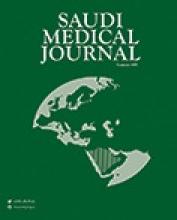Abstract
OBJECTIVE: To investigate whether postmenopausal bleeding (PMB) in our postmenopausal patients is a significant early symptom of uterine cancer (UC) and to assess risk factors for developing the disease in our population.
METHODS: A retrospective observational study conducted at King Fahad National Guard Hospital (KFNGH), Riyadh, Kingdom of Saudi Arabia. A review of documents was carried out from PMB patients who were admitted to the hospital from January 1990 through to December 2000. Factors that are usually associated with UC were studied (age, body mass index, parity, menopausal duration, past medical history, ultrasound endometrial thickness, and number of PMB episodes).
RESULTS: Forty-seven/one hundred and ninety-five patients (24.1%) were found to have UC. One hundred and forty-eight/one hundred and ninety-five patients (75.9%) had no pathology or a benign pathology. After adjustment for confounding variables, patient's is age >60-years and occurrence of >/=2 episodes of PMB were the risk factors significantly related to UC development. Age 61-70-years P=0.02, odds ratio (OR) 6.8, 95% confidence interval (CI) 1.4-32.9. Age >70-years P=0.001, OR 28.4, 95% CI 3.5-156.3. Occurrence of >/= 2 episodes of PMB P=0.005, OR 4.5, 95% CI 1.6-11.8. Endometrial thickness >5mm, diabetes, hypertension and obesity were not found to be among the risk factors associated with UC development.
CONCLUSION: Patient's age >60-years and occurrence of >/=2 episodes of PMB were the risk factors significantly related to UC development in saudi patients with PMB. National risk factors assessment though case control study is required.
- Copyright: © Saudi Medical Journal
This is an open-access article distributed under the terms of the Creative Commons Attribution-Noncommercial-Share Alike 3.0 Unported, which permits unrestricted use, distribution, and reproduction in any medium, provided the original work is properly cited.






